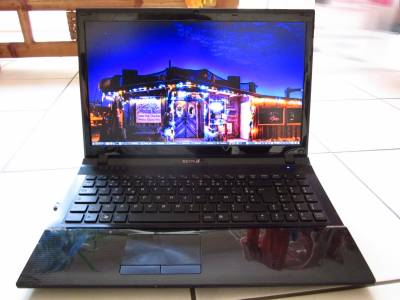Keynux Epure S4 laptop review

Main thoughts
I bought a Keynux Epure S4 three mouths ago now and it is time to turn it out. At the risk of spoiling, I can already tell you that this laptop rocks and is a good deal. Why did I bought a Keynux in the first place ? simply because it was (AFAIK in December 2011) the only French laptop assembler dealing with my three main criteria :
- Running as good as possible under Linux.
- No Microsoft tax.
- Custom and fine grained hardware choice.
I use this laptop mainly for development, to run virtual machines (along with a "regular" browsing / office use of course). I (almost) don't play games or have others high GPU usages. My main strategy was to select the less expensive Keynux laptop and then to move upmarket the most important components for me (like hard drive, CPU and memory). It cost me around 1400 € (VTA and transport included).
Specifications
- Model website and specifications
- My custom Epure is basically (see complete specifications bellow for
more details) :
- a Clevo W251HSQ laptop chassis.
- an i7 dual core CPU with hyperthreading, the OS sees 2x2= 4 CPU (note that most others i7 are quad-cores : the OS seems 8 CPU but a dual core is fine for development).
- a built-in Intel HD Graphics 3000 GPU.
- a 500GB XT SSD/HS Seagate hybrid.
- 8 GB SO-DIMM RAM DDR-3 / 1333 MHz (2 x 4 Go) RAM.
I hesitated between a pure SSD and hybrid hard disk and finally bought the hybrid to get more storage at the best price and because my usage implies a lot of writes during VM executions. I'm very happy with this solution and the boot takes about 20 secs.
Linux configuration

I use a xubuntu 11.10 desktop. Xfce is a lightweight desktop manager allowing to boot faster and to save memory, power and CPU at usage (a screenshot of my laptop on your right).
Kernel boot options
(Grub configuration under /etc/default/grub under Ubuntu) : GRUB_CMDLINE_LINUX_DEFAULT="quiet splash acpi_osi= i915.modeset=1 add_efi_memmap i915.i915_enable_rc6=7 i915.i915_enable_fbc=1 i915.lvds_downclock=1"
- acpi_osi= makes the lightness Fn keys to work (don't ask me)...
- acpi_osi= i915.modeset=1 add_efi_memmap i915.i915_enable_rc6=7 i915.i915_enable_fbc=1 i915.lvds_downclock=1 enables the GPU eco mode (thanks Jean-Baptiste) : saves me around 50% of power consumption and 10 degrees (and hence makes the fan mush less noisy in the same time). Power measures on batteries (using powertop) : dropped from 37 watts to 22 watts.
- Don't use the pcie_aspm=force option to save more power (see here), some components (probably the Ethernet card) doesn't support ASPM and I got random freezes when plugging the Ethernet cable for instance).
Xubuntu configuration
- The sound was always muted at startup. To fix that, store the current volume state using alsactl :
sudo alsactl store
- Out of the box, my LG LED projector didn't display any image neither in VGA nor in HDNI mode. After i915 Xorg drivers upgrades, the HNDI works. You can install them using this PPA repository.
Issues
- VGA display don't work with my LG LED projector (see previous item) but it does with my HP external screen so it must be specific to the projector (it worked with my previous Lenovo however).
The good
- Very smart and plain chassis (I would suggest a M505 black mouse along with it for a perfect look).
- Gorgeous 1600x900 screen. Very good color display.
- Price : without the Microsoft tax, you get about 150 € and this laptop should be about 200 € less expensive than a comparable Lenovo.
- Impressively fast for development usage.
- Standard charger standards (I even managed to recycle an old charger).
- The keyword typing feeling is very pleasant.
- Light packaging
- Reactive and professional support.

The bad
- No embedded light (to light keyboards up in the dark).
- No physical wifi ON/OFF nor volume buttons.
- Only three USB 2 ports.
- The Ethernet plug is inverted (pin points toward the ground) and has no activity LED.
Small troubles
- The screen can be opened only by around 100 degrees from the keyboard. Higher opening can be useful when using the laptop on some ergonomic supports.
- The power plug is not very well positioned (on the left, I would prefer on the right) and feels fragile.
- By default, the French 220V plug bents at an angle. This makes unplugging very difficult. I had to change for a straight plug cable.
- The LED on the charger is annoying when used in a dark room.
- The BIOS cannot be parametrized (beside time and few others things). However, it's a way to make the laptop safer.
- The "End" and "Begin" keys are mixed with the numeric keys and makes their use confusing, I would prefer independent keys.
- No "pseudo wheel" on the touch pad.

 Bertrand Florat
Tech articles
Others articles
Projects
Cours
Contact
Bertrand Florat
Tech articles
Others articles
Projects
Cours
Contact
